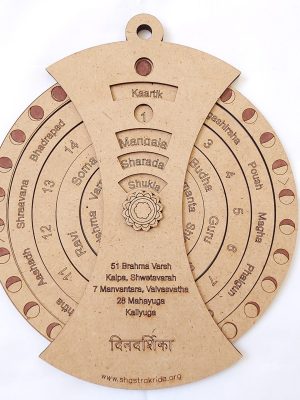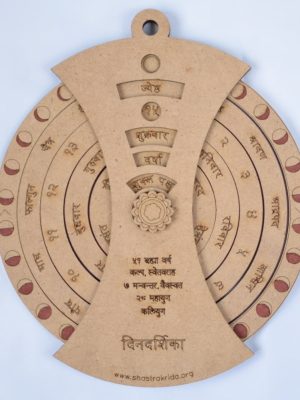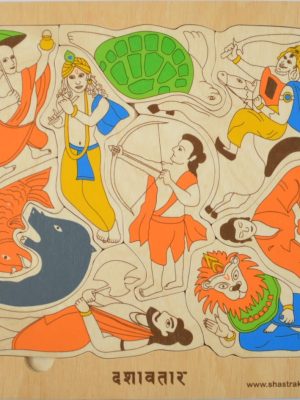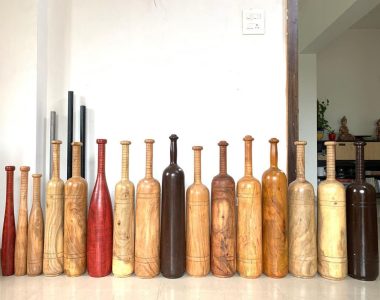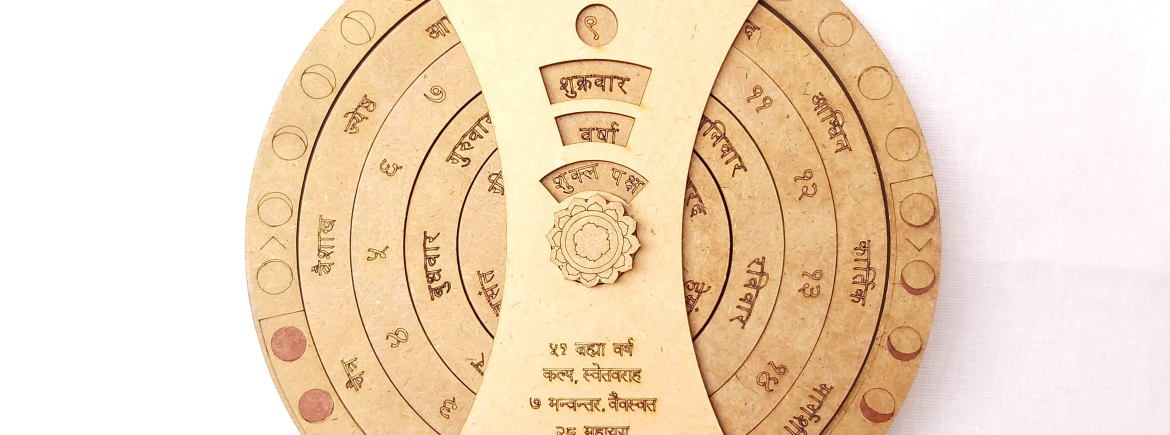
Our ancestors used to keep track of bigger time units such as days and seasons concerning the celestial movements such as phases of the Moon and positions of Nakshatras. For small-time measurements, devices like Sundials were used.
The Hindu calendar is a lunisolar calendar, meaning a mix of lunar and solar calendars. It is based on sidereal year but adjusts moon cycles into it, to bring it in agreement with the seasons. In a purely lunar calendar like the Islamic calendar- months move forward by about 11 days every solar year. But the Hindu calendar, which is lunisolar, tries to fit together the cycle of lunar months and the solar year in a single framework, by adding adhik-mass every 2-3 years. The concept of Adhik-Maas is unique to the traditional Hind lunar calendars, for example, in the 2012 calendar, there were 13 months with an Adhik-Maas falling between August 18 and September 16.
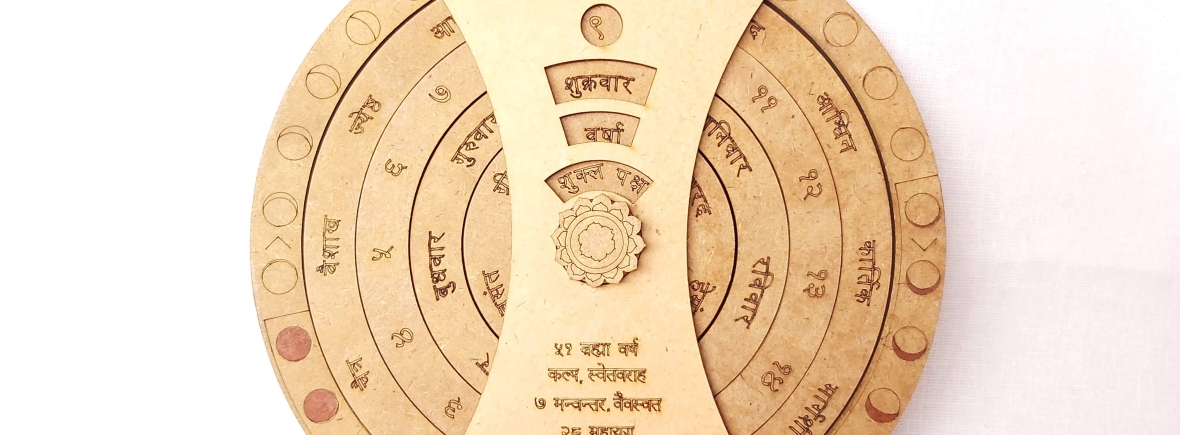
The Hindu Calendar still shifts slowly the seasons due to the precession of the Earth’s axis. As a result, Uttrayan (Makar-Sankranti or Pongal, marking the day of the year when the Sun starts moving towards (North) which is usually celebrated around January 14, actually falls on the 22 of December as it is on this date that the Sun is at the southernmost point, as seen from Earth.
Added to all this is the slowing down of the Earth’s rotation due to tides, and the recession of the Moon from Earth. Extrapolated backwards, Earth’s Day length was perhaps very short (5-6 hours) during its first billion years, and in the distant future, the day will become much longer. Moon was much nearer, with many more days in a lunar month. Eventually, the day and night cycle should stop with one side of Earth always facing the Sun and the opposite side of Earth in a perpetual dark, with no further need for any calendar.
Shastra Krida Brand at Indic Brands strives to develop play concepts that inculcate Vedic wisdom in children too, in their favourite way of playing. The “Dindarshika” design is an attempt to connect kids with the natural forces (Moon) responsible for the indicators of the time and teach them about the lunisolar concept of the Hindu calendar.
This Dindarshika toy design was selected for the grand final of a national competition for Indic toys called – Toycathon, (but this event is getting postponed indefinitely due to Covid-19 related lockdown). You can use the below link to buy this toy. For more information about Shastra Krida, you can visit their website here
-
 Dindarshika (English) – Vedic Calendar₹449.00
Dindarshika (English) – Vedic Calendar₹449.00 -
 Dindarshika – Vedic Calendar₹449.00
Dindarshika – Vedic Calendar₹449.00 -
 Dashavatara Puzzle- Wooden Puzzle₹399.00
Dashavatara Puzzle- Wooden Puzzle₹399.00
Three natural clocks
From almost the dawn of civilization, the man noticed that many phenomena in nature were repetitive. The most basic cycle was the aberration of day and night. This is due to our most basic natural clock, viz the rotation of the Earth, causing the rising and setting of the Sun, giving rise to alternative periods of light and darkness. All humans and animal life has evolved accordingly, keeping awake during the day but sleeping through the night.
The next natural clock in terms of importance is the revolution of the Earth around the Sun. Early humans noticed that over a certain period, the seas changed, following a fixed pattern. Near the tropics for instance, over most of India – the hot summer gives way to main, which is followed by a cool winter. Further away from the equator, there were four distinct seasons spring summer, autumn, and winter. This period is defined as a year.
The third clock in the revolution of the Moon around the Earth. The phases of the Moon were a curious phenomenon, which repeated over a period, called a month. Though many religious and social customs became tied to the cycle of the seasons, often their timings got fixed concerning the phases of the Moon. Unlike the day, month and year, the week is an entirely artificial unit of time. The week probably first came into existence when man began trading regularly, it perhaps marked working days repetitively followed by a holiday. The week varied in length in different parts of the world. Some African tribes used a 4-day week, the Central American week was 5 days long and the ancient Romans utilised 8 days intervals, most societies eventually settled on 7 days a week.
Extra Activity: Watch Out this video by Prachyam to understand Indian Logic for the sequence of weekdays.
With “time”, most of us have comfortably moved to modern Calendar designs that usually hang on a wall or appear on some digital devices. This has created a dependency on such external devices to know even the day of a month. The use of devices is not an issue, but slowly and surely, we have forgotten the connection between us and nature and the science behind keeping track of time. In a way, these new designs have created a barrier between us and nature. The Gregorian calendar is purely solar it ignores the moon completely and relates important days only to the time of the year. There is a widely used calendar that is purely a lunar Islamic calendar it ignores the sun completely. The Dindarshika is an attempt to remove this barrier, rather not allowing it to build right from a very young age.
The most common Indian calendar is lunisolar, taking both the sun and moon into account. It tries to fit together the cycle of lunar months and the solar year in a single framework.
In Hindu culture, the measurement of time as per these natural forces is of much importance. Every occasion right from birth, education, marriage, and death is celebrated or observed only based on this traditional system. Even though some of us use the panchang to see the alignment of planets to celebrate most occasions, unfortunately, many of us do not know even our birthday in our traditional system. It’s not that complicated to know as it has always been portrayed and on which we heavily rely. The key is to start early as for every other thing, we put conscious efforts to give exposure to our kids to the traditional Indian way of measuring time.
For export and international shipping-related Inquiry please Contact us. This Learning Toy is a must-have for your kids to understand the different concepts of Hindu Callender systems.
Follow our Non-Profit Organization Hindu Media Wiki on Twitter at this link. Hindu Media Wiki is a Resource sharing and discussion site for followers of the Hindu religion and those interested in learning more about Hinduism.

